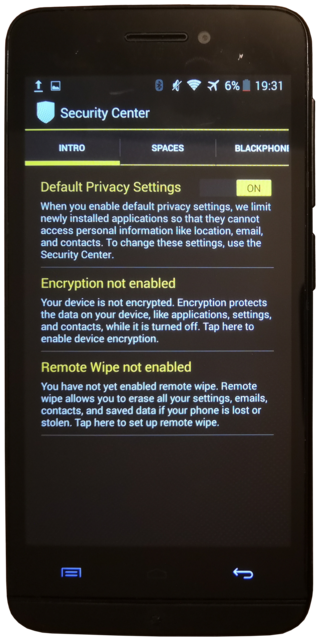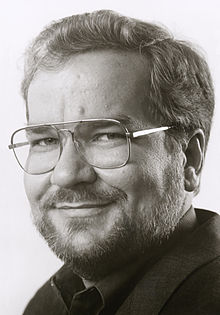Pretty Good Privacy (PGP) is an encryption program that provides cryptographic privacy and authentication for data communication. PGP is used for signing, encrypting, and decrypting texts, e-mails, files, directories, and whole disk partitions and to increase the security of e-mail communications. Phil Zimmermann developed PGP in 1991.
A cypherpunk is any individual advocating widespread use of strong cryptography and privacy-enhancing technologies as a route to social and political change. Originally communicating through the Cypherpunks electronic mailing list, informal groups aimed to achieve privacy and security through proactive use of cryptography. Cypherpunks have been engaged in an active movement since at least the late 1980s.

GNU Privacy Guard is a free-software replacement for Symantec's PGP cryptographic software suite. The software is compliant with RFC 4880, the IETF standards-track specification of OpenPGP. Modern versions of PGP are interoperable with GnuPG and other OpenPGP-compliant systems. GnuPG is however expected to break compliance with the upcoming revision of OpenPGP and thus with other implementations that will continue to comply.

The Clipper chip was a chipset that was developed and promoted by the United States National Security Agency (NSA) as an encryption device that secured "voice and data messages" with a built-in backdoor that was intended to "allow Federal, State, and local law enforcement officials the ability to decode intercepted voice and data transmissions." It was intended to be adopted by telecommunications companies for voice transmission. Introduced in 1993, it was entirely defunct by 1996.

Werner Koch is a German free software developer. He is best known as the principal author of the GNU Privacy Guard. He was also Head of Office and German Vice-Chancellor of the Free Software Foundation Europe. He is the winner of Award for the Advancement of Free Software in 2015 for founding GnuPG.

The export of cryptography from the United States to other countries has experienced various levels of restrictions over time. World War II illustrated that code-breaking and cryptography can play an integral part in national security and the ability to prosecute war. Changes in technology and the preservation of free speech have been competing factors in the regulation and constraint of cryptographic technologies for export.

A secure telephone is a telephone that provides voice security in the form of end-to-end encryption for the telephone call, and in some cases also the mutual authentication of the call parties, protecting them against a man-in-the-middle attack. Concerns about massive growth of telephone tapping incidents led to growing demand for secure telephones.
PGPfone was a secure voice telephony system developed by Philip Zimmermann in 1995. The PGPfone protocol had little in common with Zimmermann's popular PGP email encryption package, except for the use of the name. It used ephemeral Diffie-Hellman protocol to establish a session key, which was then used to encrypt the stream of voice packets. The two parties compared a short authentication string to detect a Man-in-the-middle attack, which is the most common method of wiretapping secure phones of this type. PGPfone could be used point-to-point over the public switched telephone network, or over the Internet as an early Voice over IP system.

PGP Corporation was a company that sold Pretty Good Privacy computer software. It was founded in 2002, and acquired by Symantec in 2010, and by Broadcom in 2019.
Below is a timeline of notable events related to cryptography.
Zfone is software for secure voice communication over the Internet (VoIP), using the ZRTP protocol. It is created by Phil Zimmermann, the creator of the PGP encryption software. Zfone works on top of existing SIP- and RTP-programs, but should work with any SIP- and RTP-compliant VoIP-program.
ZRTP is a cryptographic key-agreement protocol to negotiate the keys for encryption between two end points in a Voice over IP (VoIP) phone telephony call based on the Real-time Transport Protocol. It uses Diffie–Hellman key exchange and the Secure Real-time Transport Protocol (SRTP) for encryption. ZRTP was developed by Phil Zimmermann, with help from Bryce Wilcox-O'Hearn, Colin Plumb, Jon Callas and Alan Johnston and was submitted to the Internet Engineering Task Force (IETF) by Zimmermann, Callas and Johnston on March 5, 2006 and published on April 11, 2011 as RFC 6189.
Cryptography is the practice and study of encrypting information, or in other words, securing information from unauthorized access. There are many different cryptography laws in different nations. Some countries prohibit export of cryptography software and/or encryption algorithms or cryptoanalysis methods. Some countries require decryption keys to be recoverable in case of a police investigation.
In cryptography, BassOmatic is the symmetric-key cipher designed by Phil Zimmermann as part of his email encryption software PGP. Comments in the source code indicate that he had been designing the cipher since as early as 1988, but it was not publicly released until 1991. After Eli Biham pointed out to him several serious weaknesses in the BassOmatic algorithm over lunch at the 1991 CRYPTO conference, Zimmermann replaced it with IDEA in subsequent versions of PGP.

Adam Back is a British cryptographer and cypherpunk. He is the CEO of Blockstream, which he co-founded in 2014. He invented Hashcash, which is used in the Bitcoin mining process.
Secure messaging is a server-based approach to protect sensitive data when sent beyond the corporate borders, and it provides compliance with industry regulations such as HIPAA, GLBA and SOX. Advantages over classical secure e-mail are that confidential and authenticated exchanges can be started immediately by any internet user worldwide since there is no requirement to install any software nor to obtain or to distribute cryptographic keys beforehand. Secure messages provide non-repudiation as the recipients are personally identified and transactions are logged by the secure email platform.

Jon Callas is an American computer security expert, software engineer, user experience designer, and technologist who is the co-founder and former CTO of the global encrypted communications service Silent Circle. He has held major positions at Digital Equipment Corporation, Apple, PGP, and Entrust, and is considered "one of the most respected and well-known names in the mobile security industry." Callas is credited with creating several Internet Engineering Task Force (IETF) standards, including OpenPGP, DKIM, and ZRTP, which he wrote. Prior to his work at Entrust, he was Chief Technical Officer and co-founder of PGP Corporation and the former Chief Technical Officer of Entrust.
Silent Circle is an encrypted communications firm based in Washington DC. Silent Circle provides multi-platform secure communication services for mobile devices and desktop. Launched October 16, 2012, the company operates under a subscription business model. The encryption part of the software used is free software/open source and peer-reviewed. For the remaining parts of Silent Phone and Silent Text, the source code is available on GitHub, but under proprietary software licenses.

Vincent (Vinnie) Moscaritolo is a retired American computer security expert known for his work in encryption applications for mobile devices. After decades in the computer industry, he now volunteers as a search and rescue professional. He holds NREMT, WFR, and Amateur Radio Extra Class and a General Radiotelephone Operator with Ships Radar License.

The Blackphone is a smartphone built to ensure privacy, developed by SGP Technologies, a wholly owned subsidiary of Silent Circle. Originally, SGP Technologies was a joint venture between the makers of GeeksPhone and Silent Circle. Marketing is focused upon business users, stressing that employees often conduct business using private devices and services that are not secure and that the Blackphone service readily provides users with options that ensure confidentiality when needed. Blackphone provides Internet access through VPN. The device runs a modified version of Android called SilentOS that comes with a bundle of security-minded tools.









